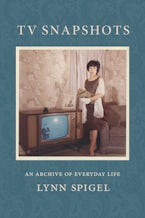“In this brilliant book Lynn Spigel examines TV snapshots as an activity, hobby art, expressive medium, and a thing people did with television, convincingly arguing for the importance of thinking about how photography and television work together. She reorients television studies away from programs and questions of spectatorship toward an exploration of the home as a ‘theater of everyday life,’ offering a diverse picture of how people use television, what the medium means, and where and how people live. I love this book and can’t wait to teach it.”
- Pamela Robertson Wojcik, author of (The Apartment Plot: Urban Living in American Film and Popular Culture, 1945 to 1975) "Spigel uses midcentury photographs of people posing next to television sets to construct a fascinating study of Americana. . . . A vital addition to media studies and popular culture collections."
- Claire Sewell (Library Journal) "Spigel indicates that she worked on the book during the years when the center of gravity of television shifted from broadcast to digital streaming. Her archive of snapshots documents a phase of the medium's development shrinking into the rearview mirror. But they are also artifacts embodying something now much more familiar. The compact camera and the TV set correspond to two phases in the circulation of imagery: production and consumption respectively. In these snapshots, the image cycle is limited: flow, not a flood. The screen remains part of domestic space-and not yet, as it's becoming now, a home of sorts in its own right."
- Scott McLemee (Inside Higher Ed) "Spigel has yet again shown herself to be a signal historian of the family, helping us make sense of the ways we actually were, in the flickering light of the pressure to be otherwise."
- Hannah Zeavin (New York Review of Books) “Spigel dives deep into histories of race, sexuality, family and domesticity, architecture, and more, as they are called up by these snapshots. The result is a rich, wide-ranging historical account of cultural, social, and familial practices surrounding both television and photography that extrapolate what are often considered to be the dominant uses of these two media.”
- Bruno Guaraná (Film Quarterly) "Displaying a sophisticated mastery of media studies, photographic history, and contemporary art theory, Spigel shifts seamlessly through a wide span of intellectual underpinnings. . . . At times whimsical and frequently revealing gender and class relationships, this work is engaging and thoughtful. Highly recommended. Advanced undergraduates through faculty."
- D. McClure (Choice) "Spigel offers fresh perspectives on how people lived with televisions-a new communication technology-in their homes during the postwar period. TV Snapshots would interest scholars of television studies, media history, American studies, photography, and cultural studies." - Elizabeth Patton (Television & New Media) "The primary delight of this book is its collection of photographs and these amateur “stars” posing with their TVs. The sheer variety and idiosyncrasy of the TV- adjacent practices pictured in these snapshots, a panoply of unruly and mundane activities that do not conform to the dictates of proper television watching and midcentury homelife, is truly something to behold. Even without the rich contextualization and incisive analysis of Spigel’s writing, the images themselves are beguiling and substantive." - Brad Stiffler (Cultural Critique) "Although Lynn Spigel is also writing about televisions impact on our ever-increasingly mediated culture, her fresh approach is to consider televisions role in everyday life not solely by considering what people watched, or indeed how they watched. . . . Her insights into the different uses of television sets in the home are engaging, surprising, and reassuring as she encourages readers to become spectators in the homes of people from the past. . . . Spigel's call to arms to ‘listen to images’ (p.262) to see TV culture anew will be important for scholars of social history, media, domesticity, material culture and gender." - Kevin Geddes (Historical Journal of Film, Radio & Television) "While pointing ahead to possible futures for feminist television studies, this book is an accessible and well-illustrated read that will appeal not only to scholars of the medium but also to those with an interest in the potential of visual media to shape, alter, and commemorate the everyday." - Abigail Jenkins (Critical Studies in Television)

